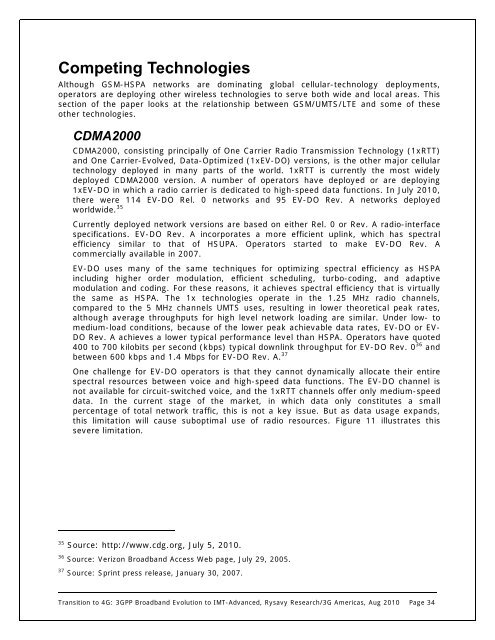3GPP Broadband Evolution to IMT-Advanced - 4G Americas
3GPP Broadband Evolution to IMT-Advanced - 4G Americas
3GPP Broadband Evolution to IMT-Advanced - 4G Americas
- No tags were found...
You also want an ePaper? Increase the reach of your titles
YUMPU automatically turns print PDFs into web optimized ePapers that Google loves.
Competing TechnologiesAlthough GSM-HSPA networks are dominating global cellular-technology deployments,opera<strong>to</strong>rs are deploying other wireless technologies <strong>to</strong> serve both wide and local areas. Thissection of the paper looks at the relationship between GSM/UMTS/LTE and some of theseother technologies.CDMA2000CDMA2000, consisting principally of One Carrier Radio Transmission Technology (1xRTT)and One Carrier-Evolved, Data-Optimized (1xEV-DO) versions, is the other major cellulartechnology deployed in many parts of the world. 1xRTT is currently the most widelydeployed CDMA2000 version. A number of opera<strong>to</strong>rs have deployed or are deploying1xEV-DO in which a radio carrier is dedicated <strong>to</strong> high-speed data functions. In July 2010,there were 114 EV-DO Rel. 0 networks and 95 EV-DO Rev. A networks deployedworldwide. 35Currently deployed network versions are based on either Rel. 0 or Rev. A radio-interfacespecifications. EV-DO Rev. A incorporates a more efficient uplink, which has spectralefficiency similar <strong>to</strong> that of HSUPA. Opera<strong>to</strong>rs started <strong>to</strong> make EV-DO Rev. Acommercially available in 2007.EV-DO uses many of the same techniques for optimizing spectral efficiency as HSPAincluding higher order modulation, efficient scheduling, turbo-coding, and adaptivemodulation and coding. For these reasons, it achieves spectral efficiency that is virtuallythe same as HSPA. The 1x technologies operate in the 1.25 MHz radio channels,compared <strong>to</strong> the 5 MHz channels UMTS uses, resulting in lower theoretical peak rates,although average throughputs for high level network loading are similar. Under low- <strong>to</strong>medium-load conditions, because of the lower peak achievable data rates, EV-DO or EV-DO Rev. A achieves a lower typical performance level than HSPA. Opera<strong>to</strong>rs have quoted400 <strong>to</strong> 700 kilobits per second (kbps) typical downlink throughput for EV-DO Rev. 0 36 andbetween 600 kbps and 1.4 Mbps for EV-DO Rev. A. 37One challenge for EV-DO opera<strong>to</strong>rs is that they cannot dynamically allocate their entirespectral resources between voice and high-speed data functions. The EV-DO channel isnot available for circuit-switched voice, and the 1xRTT channels offer only medium-speeddata. In the current stage of the market, in which data only constitutes a smallpercentage of <strong>to</strong>tal network traffic, this is not a key issue. But as data usage expands,this limitation will cause suboptimal use of radio resources. Figure 11 illustrates thissevere limitation.35 Source: http://www.cdg.org, July 5, 2010.36 Source: Verizon <strong>Broadband</strong> Access Web page, July 29, 2005.37 Source: Sprint press release, January 30, 2007.Transition <strong>to</strong> <strong>4G</strong>: <strong>3GPP</strong> <strong>Broadband</strong> <strong>Evolution</strong> <strong>to</strong> <strong>IMT</strong>-<strong>Advanced</strong>, Rysavy Research/3G <strong>Americas</strong>, Aug 2010 Page 34
















